Kazakh education system Origin, nature, evolution Education culture






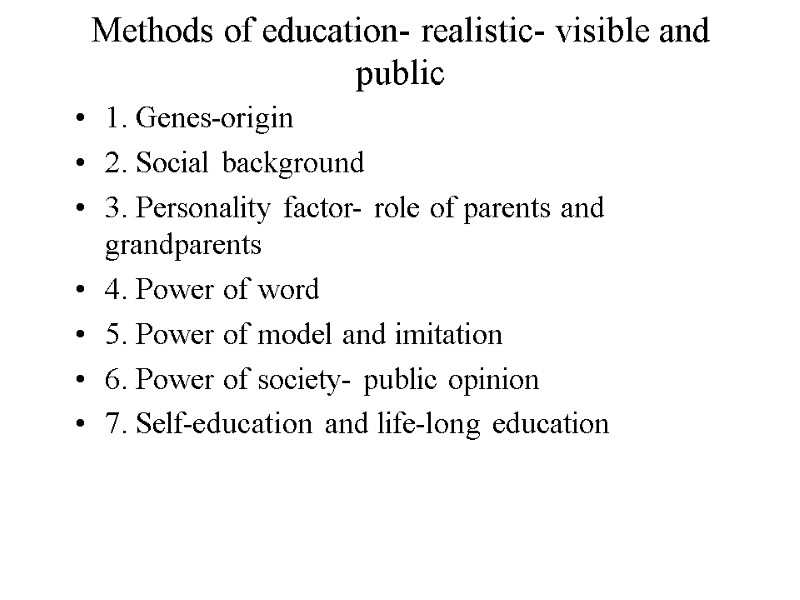


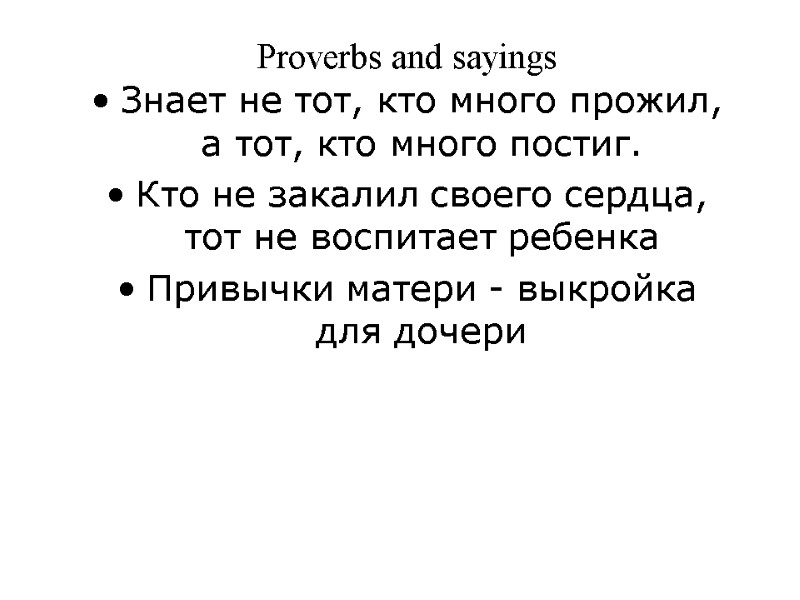


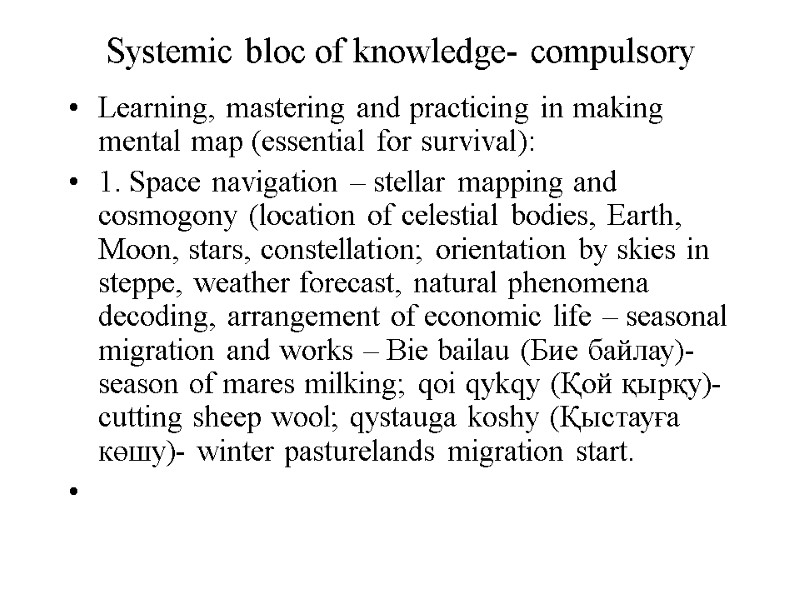





















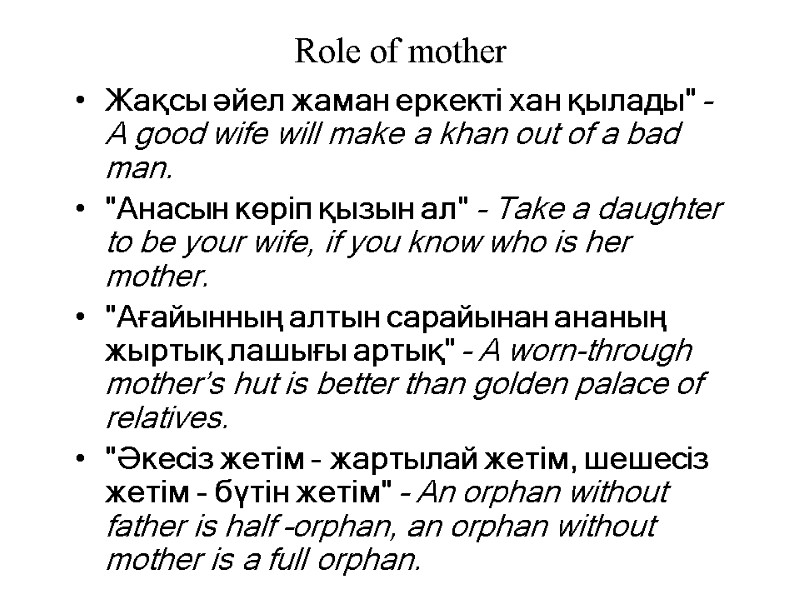














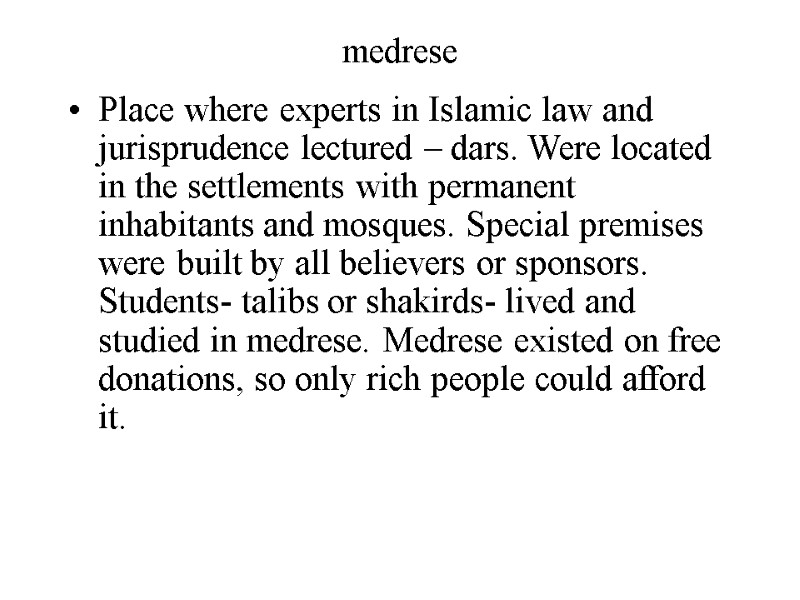



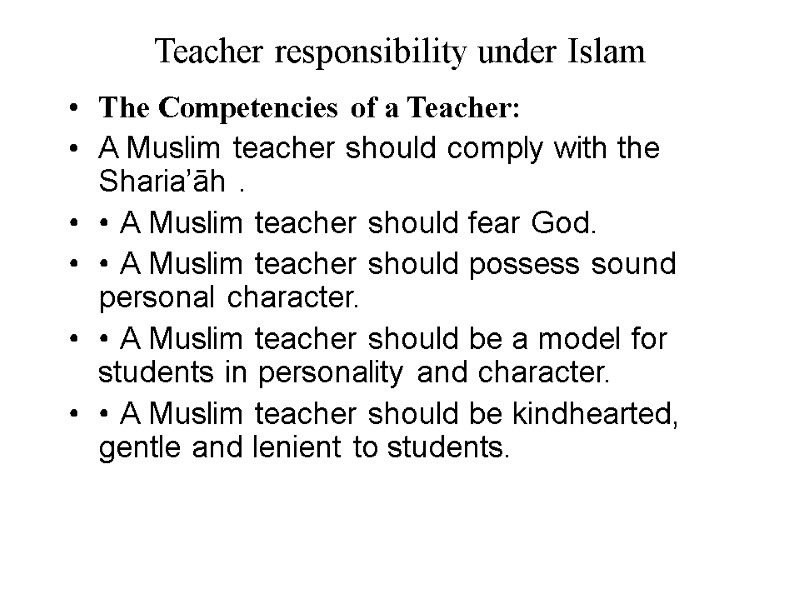



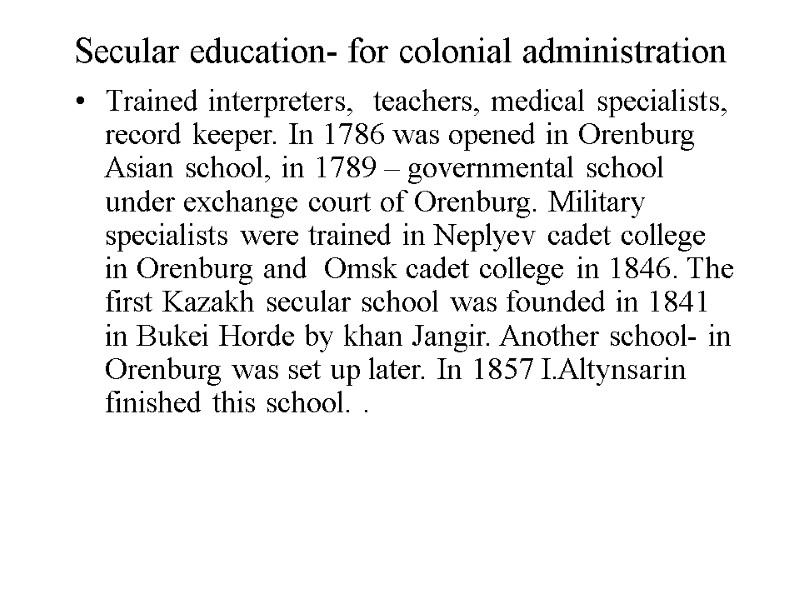


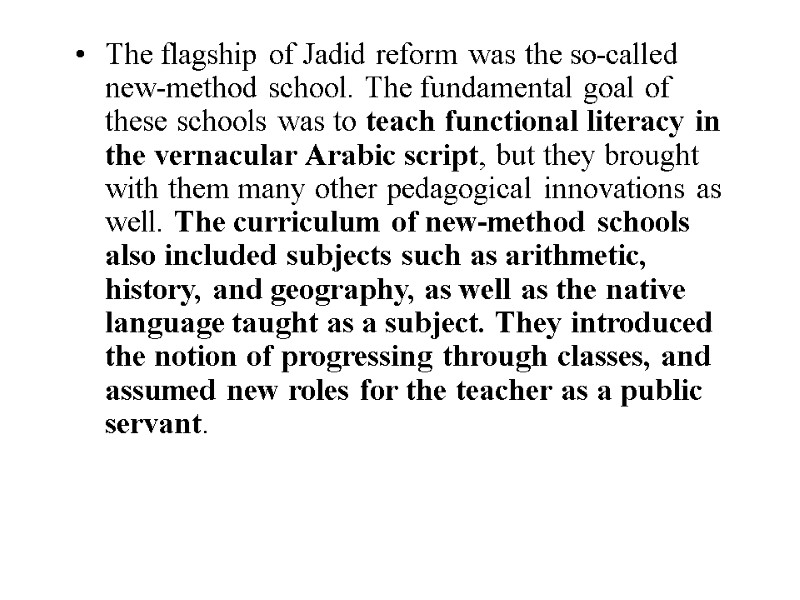

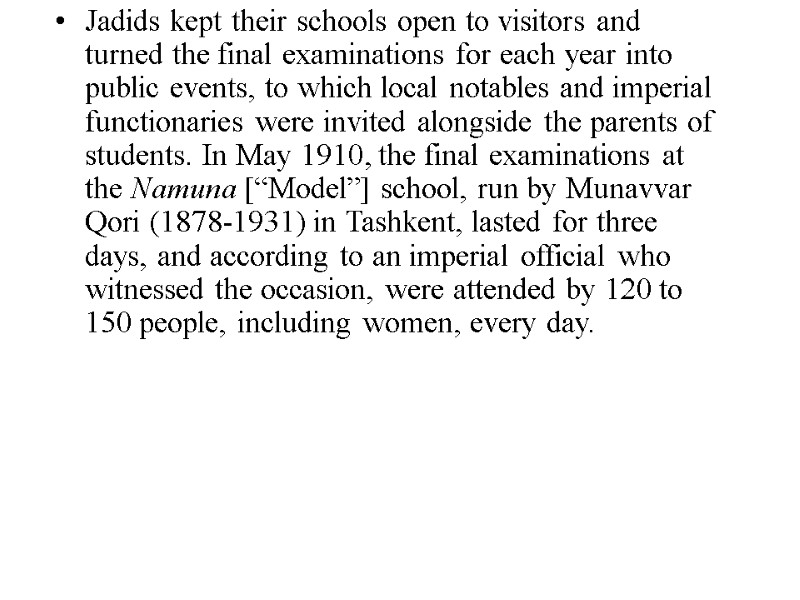




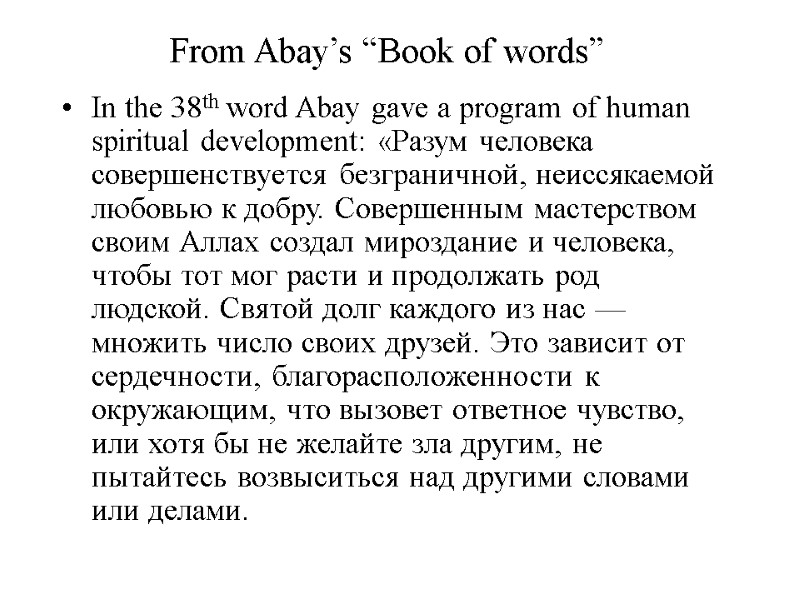




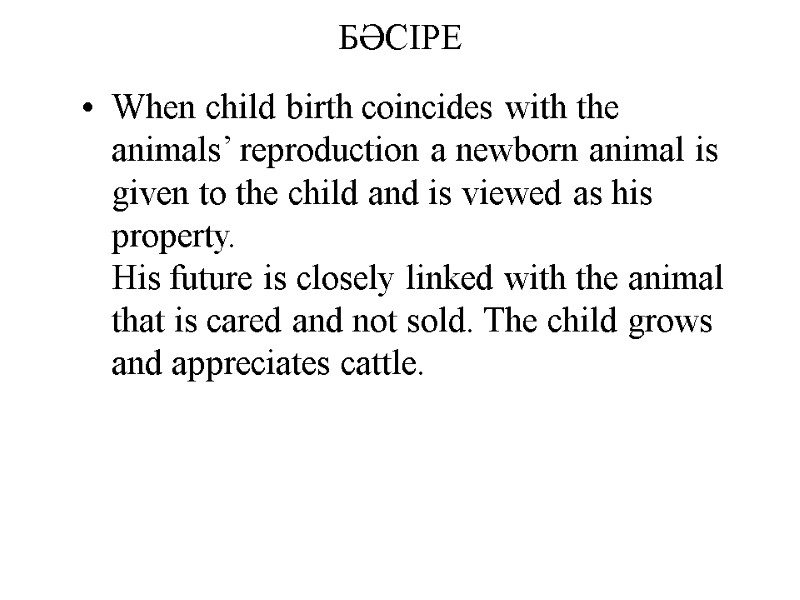

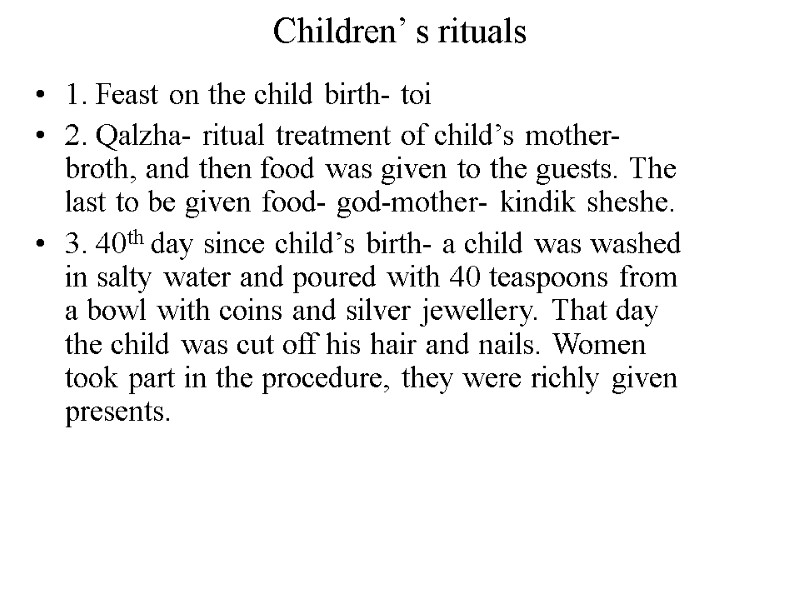






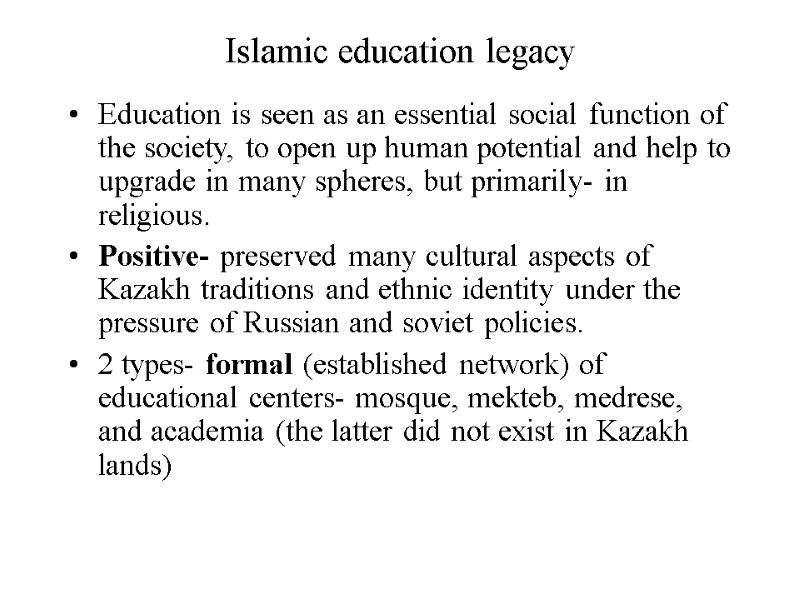
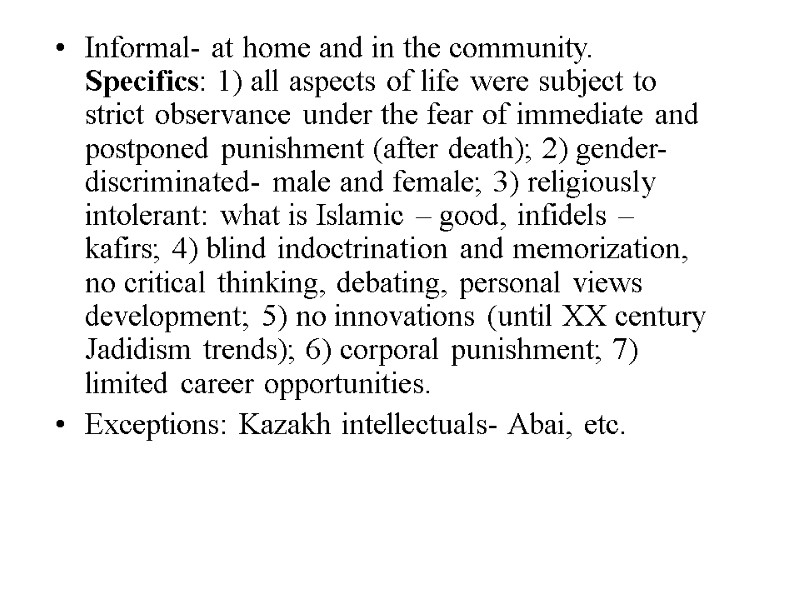







9678-kazakh_education_system.ppt
- Количество слайдов: 89
 Kazakh education system Origin, nature, evolution
Kazakh education system Origin, nature, evolution
 Education culture The system of life-long practices aimed to produce a man or woman as a regular and responsible member of the community. Major components: A) society- elements of social-cultural heritage transmitted by special codes from generation to generation as regulators of sustainable development B) family C) individual
Education culture The system of life-long practices aimed to produce a man or woman as a regular and responsible member of the community. Major components: A) society- elements of social-cultural heritage transmitted by special codes from generation to generation as regulators of sustainable development B) family C) individual
 Basic types- informal and formal Informal – unorganized educational activities when one acquires knowledge, skills, attitudes and insights from daily experiences at home, at work, at play, interactions, copying and imitating. Formal -institutionalized, chronologically graded, and well structured education system under guidance in system, by special rules. In Kazakh lands - since Russian times, rare- in southern areas Islamic schooling.
Basic types- informal and formal Informal – unorganized educational activities when one acquires knowledge, skills, attitudes and insights from daily experiences at home, at work, at play, interactions, copying and imitating. Formal -institutionalized, chronologically graded, and well structured education system under guidance in system, by special rules. In Kazakh lands - since Russian times, rare- in southern areas Islamic schooling.
 Historical traditions 1. Nomadic 2. Islamic 3. Mongol 4. Russian 5. Soviet 6. Western/globalization
Historical traditions 1. Nomadic 2. Islamic 3. Mongol 4. Russian 5. Soviet 6. Western/globalization
 "Бірінші байлық - денсаулық, екінші байлық - ақ жаулық, үшінші байлық - бес саулық" – The first wealth- is health, the second- is family, the third- cattle. Білімі жоқ ұл – жұпары жоқ гүл. A man without knowledge is like a flower without smell. Талапты бала – талпынған кұстай. A smart son is like a bird ready to fly.
"Бірінші байлық - денсаулық, екінші байлық - ақ жаулық, үшінші байлық - бес саулық" – The first wealth- is health, the second- is family, the third- cattle. Білімі жоқ ұл – жұпары жоқ гүл. A man without knowledge is like a flower without smell. Талапты бала – талпынған кұстай. A smart son is like a bird ready to fly.
 Methods of education- realistic- visible and public 1. Genes-origin 2. Social background 3. Personality factor- role of parents and grandparents 4. Power of word 5. Power of model and imitation 6. Power of society- public opinion 7. Self-education and life-long education
Methods of education- realistic- visible and public 1. Genes-origin 2. Social background 3. Personality factor- role of parents and grandparents 4. Power of word 5. Power of model and imitation 6. Power of society- public opinion 7. Self-education and life-long education
 Power of word Epithets, hyperbolas, rhetoric questions, exclamations, lexical forms, morphology, etc. All is united by rhythm, composition, melody, etc.
Power of word Epithets, hyperbolas, rhetoric questions, exclamations, lexical forms, morphology, etc. All is united by rhythm, composition, melody, etc.
 Басқа пәле тілден. -My language is my enemy. Ештен кеш жақсы. – It is better late than never. Ақша тиыннан құралады. -A coin saves a rouble/banknote. Үндемеген үйдей пәледен құтылады. -Silence saves from bigger trouble.
Басқа пәле тілден. -My language is my enemy. Ештен кеш жақсы. – It is better late than never. Ақша тиыннан құралады. -A coin saves a rouble/banknote. Үндемеген үйдей пәледен құтылады. -Silence saves from bigger trouble.
 Proverbs and sayings Знает не тот, кто много прожил, а тот, кто много постиг. Кто не закалил своего сердца, тот не воспитает ребенка Привычки матери - выкройка для дочери
Proverbs and sayings Знает не тот, кто много прожил, а тот, кто много постиг. Кто не закалил своего сердца, тот не воспитает ребенка Привычки матери - выкройка для дочери
 Білімі жоқ ұл – жұпары жоқ гүл. Человек без знаний, что цветы без запаха. Талапты бала – талпынған кұустай. Толковый сын, что птица, готовая к взлету
Білімі жоқ ұл – жұпары жоқ гүл. Человек без знаний, что цветы без запаха. Талапты бала – талпынған кұустай. Толковый сын, что птица, готовая к взлету
 Teaching methodology Instructions, tutoring, encouragement, blessing,
Teaching methodology Instructions, tutoring, encouragement, blessing,
 Systemic bloc of knowledge- compulsory Learning, mastering and practicing in making mental map (essential for survival): 1. Space navigation – stellar mapping and cosmogony (location of celestial bodies, Earth, Moon, stars, constellation; orientation by skies in steppe, weather forecast, natural phenomena decoding, arrangement of economic life – seasonal migration and works – Bie bailau (Бие байлау)- season of mares milking; qoi qykqy (Қой қырқу)- cutting sheep wool; qystauga koshy (Қыстауға көшу)- winter pasturelands migration start.
Systemic bloc of knowledge- compulsory Learning, mastering and practicing in making mental map (essential for survival): 1. Space navigation – stellar mapping and cosmogony (location of celestial bodies, Earth, Moon, stars, constellation; orientation by skies in steppe, weather forecast, natural phenomena decoding, arrangement of economic life – seasonal migration and works – Bie bailau (Бие байлау)- season of mares milking; qoi qykqy (Қой қырқу)- cutting sheep wool; qystauga koshy (Қыстауға көшу)- winter pasturelands migration start.
 2) natural world navigation and operating - environment and animals, naming and understanding their behavioral practices, 3) time navigation chronology and history recording by natural (jul qaiury, and jul basy) and social events (the event happed in the year of Tiger) 4) social navigation and operating –knowledge of customs, rites performance- sacral and everyday essential. Sacral- 7: 7 qabat jer (layouts of land), 7 qat kok (7 layouts of heaven), 7 galamat (7 miracles), 7 qazyna (7 treasures), 7 shelpek (7 breads), 7 ata (7 generations).
2) natural world navigation and operating - environment and animals, naming and understanding their behavioral practices, 3) time navigation chronology and history recording by natural (jul qaiury, and jul basy) and social events (the event happed in the year of Tiger) 4) social navigation and operating –knowledge of customs, rites performance- sacral and everyday essential. Sacral- 7: 7 qabat jer (layouts of land), 7 qat kok (7 layouts of heaven), 7 galamat (7 miracles), 7 qazyna (7 treasures), 7 shelpek (7 breads), 7 ata (7 generations).
 5) personal life organization- significance of age cycles rites and rituals – Mushel jas and skills one has to master by that time, behavioral model to follow and duties to observe; 6) making links between an individual, society and nature through traditional holidays - “Наурыз”, “Қымыз мұрындық”, ”Сабан той”, “Соғым”); 7) links with eternity - religious holidays (Ораза айт, Құрбан айт), etc.
5) personal life organization- significance of age cycles rites and rituals – Mushel jas and skills one has to master by that time, behavioral model to follow and duties to observe; 6) making links between an individual, society and nature through traditional holidays - “Наурыз”, “Қымыз мұрындық”, ”Сабан той”, “Соғым”); 7) links with eternity - religious holidays (Ораза айт, Құрбан айт), etc.
 Life long education Human child doe not come to this world being smart by birth. Only listening, watching, and tasting all around him, a child makes difference between good and bad. (Аbai, Book of words, 19 word.)
Life long education Human child doe not come to this world being smart by birth. Only listening, watching, and tasting all around him, a child makes difference between good and bad. (Аbai, Book of words, 19 word.)
 Adep- decency A mission of education – to indoctrinate adep- know how to behave and survive. 1) respect to seniors; 2) men to women and vice a versa; 3) social ranks.
Adep- decency A mission of education – to indoctrinate adep- know how to behave and survive. 1) respect to seniors; 2) men to women and vice a versa; 3) social ranks.
 Children were the objective of Kazakh families, it was duty of wife to produce a child. As her status depended on being fertile and bringing more sons than daughters. Daughters were guests in a family to be sold to others.
Children were the objective of Kazakh families, it was duty of wife to produce a child. As her status depended on being fertile and bringing more sons than daughters. Daughters were guests in a family to be sold to others.
 Children were seen as the basis of family welfare and happiness. “The one who brought up a daughter- left his traces in this world, but a son- stays himself”. «Son is born- sun rises», «Son is a pillar, daughter- new relatives».
Children were seen as the basis of family welfare and happiness. “The one who brought up a daughter- left his traces in this world, but a son- stays himself”. «Son is born- sun rises», «Son is a pillar, daughter- new relatives».
 Adoption practices Asyrap aly- 2) adoption of relatives’ child; 2) purchase.
Adoption practices Asyrap aly- 2) adoption of relatives’ child; 2) purchase.
 Naming Ат кою Names are beautiful, with deep meaning, often of famous people to make sure that in future the child will follow the path of greatness. The rite is guided by reputable people that bless a child. But- names of saints or too great and ill-famous people are avoided. Names are complex- month and rich- Nauryzbai (the rich born in March). Ulbosyn- let the next child be a boy after many girls.
Naming Ат кою Names are beautiful, with deep meaning, often of famous people to make sure that in future the child will follow the path of greatness. The rite is guided by reputable people that bless a child. But- names of saints or too great and ill-famous people are avoided. Names are complex- month and rich- Nauryzbai (the rich born in March). Ulbosyn- let the next child be a boy after many girls.
 To put off an evil eye were given funny names- Bashai, Koskulan, Keter, etc. In pre-1917 times names were of 3 types: 1) event; 2) Islamic; 3) nature- flora and fauna, or natural phenomena. In soviet- political- Revolutia, October, Tractorbai, etc. and introduction of western practices- Russian and European. In post-1991- revival of old times.
To put off an evil eye were given funny names- Bashai, Koskulan, Keter, etc. In pre-1917 times names were of 3 types: 1) event; 2) Islamic; 3) nature- flora and fauna, or natural phenomena. In soviet- political- Revolutia, October, Tractorbai, etc. and introduction of western practices- Russian and European. In post-1991- revival of old times.
 Islamic traditions Mullah gave a name to a child after 40 days since his birth, not later, as he could become a pray of devil/shaitan. Usually mullah asked elders on name preferences, but often he gave it himself. Then he turned a child in Mecca's direction – Kybla, and several times pronounced prayers- azan and leaning over a child pronounced his name 3 times. Then his name was registered.
Islamic traditions Mullah gave a name to a child after 40 days since his birth, not later, as he could become a pray of devil/shaitan. Usually mullah asked elders on name preferences, but often he gave it himself. Then he turned a child in Mecca's direction – Kybla, and several times pronounced prayers- azan and leaning over a child pronounced his name 3 times. Then his name was registered.
 Names usually are given in the honour of famous people, or modest for protective purposes.
Names usually are given in the honour of famous people, or modest for protective purposes.
 What makes a person perfect? Answer of Kazakh traditional pedagogic: 8 senses of understanding and 5 senses of sensation given by nature. 8 senses: 1) cognition/consciousness (hypopsis); 2) love to someone or something; 3) shame (inner emotional experience); 4), Zerde (inner aspiration of the beautiful or soul poetry); 5) natural perception and skills; 6) Ruh (inner soul sensation); 7) Zhiger (inner initiative), 8) external senses (vision, hearing, tongue, inner fear or joy feelings.
What makes a person perfect? Answer of Kazakh traditional pedagogic: 8 senses of understanding and 5 senses of sensation given by nature. 8 senses: 1) cognition/consciousness (hypopsis); 2) love to someone or something; 3) shame (inner emotional experience); 4), Zerde (inner aspiration of the beautiful or soul poetry); 5) natural perception and skills; 6) Ruh (inner soul sensation); 7) Zhiger (inner initiative), 8) external senses (vision, hearing, tongue, inner fear or joy feelings.
 Role of sons Turkic roots: son was a house and tribe keeper, to multiply the glory of ancestors. Qorqyt-ata epic: "Добрый сын - сокровенность отчая, Сын, что око одно очей его. Хороший сын - счастье, огонь в очаге не погаснет... Грубому сыну, которым имя отца не славится, из крестца отца лучше бы не явиться, Не войти в чрево матери и лучше на свет не родиться. Сыном разумным, отца прославляющим, лучше прослыть" (20, с.19).
Role of sons Turkic roots: son was a house and tribe keeper, to multiply the glory of ancestors. Qorqyt-ata epic: "Добрый сын - сокровенность отчая, Сын, что око одно очей его. Хороший сын - счастье, огонь в очаге не погаснет... Грубому сыну, которым имя отца не славится, из крестца отца лучше бы не явиться, Не войти в чрево матери и лучше на свет не родиться. Сыном разумным, отца прославляющим, лучше прослыть" (20, с.19).
 Status of girls У казахов запрещено унижать и притеснять детей женского пола. Девочка - будущая мать, дарительница и продолжательница жизни. Через деву прирастает потомство. Народные поговорки гласят: «Тонка девичья тропа», «Девичьим обаянием пьянеет сорок человек», «Девка (принадлежит и служит) - чуждой стороне». «В лике (букв. на веке) у девы селится вещий дар. Нахмурится - община натыкается на злосчастие, улыбнется - община обретает благоденствие. Унизивший девушку поражается в своих лучших правах. Дочерний (девичий) черед перекрывает дорогу сорока достойным.
Status of girls У казахов запрещено унижать и притеснять детей женского пола. Девочка - будущая мать, дарительница и продолжательница жизни. Через деву прирастает потомство. Народные поговорки гласят: «Тонка девичья тропа», «Девичьим обаянием пьянеет сорок человек», «Девка (принадлежит и служит) - чуждой стороне». «В лике (букв. на веке) у девы селится вещий дар. Нахмурится - община натыкается на злосчастие, улыбнется - община обретает благоденствие. Унизивший девушку поражается в своих лучших правах. Дочерний (девичий) черед перекрывает дорогу сорока достойным.
 Потребуется сорок ишаков, чтобы вынести груз на душе повинного в девичьих слезах». Таким образом, дочерей казахи почитают как высшую драгоценность семьи. Пришедших в гости юных особ прекрасного пола непременно усаживают на тор - почетное место. Искренне веря, что «при девице - счастья на сорок возов», гостеприимные хозяева надеются, что, посидев на тор'е, дева оставит после себя мазок своего счастья. Есть поверье и о том, что «в каждой из девчонок - сорок нестыковок».
Потребуется сорок ишаков, чтобы вынести груз на душе повинного в девичьих слезах». Таким образом, дочерей казахи почитают как высшую драгоценность семьи. Пришедших в гости юных особ прекрасного пола непременно усаживают на тор - почетное место. Искренне веря, что «при девице - счастья на сорок возов», гостеприимные хозяева надеются, что, посидев на тор'е, дева оставит после себя мазок своего счастья. Есть поверье и о том, что «в каждой из девчонок - сорок нестыковок».
 Если опрометчиво посадить ее с краю, а не во главе гостевого стола, все ее несуразицы могут остаться в этом доме. Еще говорят: «Есть в девицах пламень радушия»: привечаешь с почетом - весь ее пыл посвящается твоему дому. А еще говорят: «Есть в девицах лед равнодушия»: посадил ее у двери - считай, холод этот вскоре скует твой дом. «У девицы - сорок ангелов-хранителей». Уважаешь гостью - уважаешь и благодарных тебе ее покровителей. «У девицы - сорок дьяволов-вредителей». Пренебрегаешь гостьей - ее мрачные тени остаются у тебя пожить
Если опрометчиво посадить ее с краю, а не во главе гостевого стола, все ее несуразицы могут остаться в этом доме. Еще говорят: «Есть в девицах пламень радушия»: привечаешь с почетом - весь ее пыл посвящается твоему дому. А еще говорят: «Есть в девицах лед равнодушия»: посадил ее у двери - считай, холод этот вскоре скует твой дом. «У девицы - сорок ангелов-хранителей». Уважаешь гостью - уважаешь и благодарных тебе ее покровителей. «У девицы - сорок дьяволов-вредителей». Пренебрегаешь гостьей - ее мрачные тени остаются у тебя пожить
 Initiation rite When a boy reached the age he was to undergo initiation rite- prove his courage and heroism before the jury of the eldest. If he passed he given an adult name, became full member of clan, was free from father’s protection and went under direct control of kagan.
Initiation rite When a boy reached the age he was to undergo initiation rite- prove his courage and heroism before the jury of the eldest. If he passed he given an adult name, became full member of clan, was free from father’s protection and went under direct control of kagan.
 Atalyq By this custom parents used to delegate the right to bring up children (boys) to their subjects till they reach the age. Atalyq/atabek- was a guide, tutor trained them to horse riding, arms use, wrestling, etc. Since 6 years the boys were trained to be spiritually and physically strong and endure cold, tiredness and heat.
Atalyq By this custom parents used to delegate the right to bring up children (boys) to their subjects till they reach the age. Atalyq/atabek- was a guide, tutor trained them to horse riding, arms use, wrestling, etc. Since 6 years the boys were trained to be spiritually and physically strong and endure cold, tiredness and heat.
 Girls: copy the mother’s model
Girls: copy the mother’s model
 Role of parents "Ата - асқар тау, Ана - бауырындағы бұлақ, бала - жағасындағы құрақ" - Father- is inaccessible mountain, mother – a spring on the foot of the mountain, child – is a reed growing on the river bank. "Әкеге қарап ұл өсер" – A boy grows looking at his father. "Әке көрген оқ жонар" – Son brought up by father will make an arrow himself. Father is the only judge for his children. "Ата - балаға сыншы“. To be a good father, and pride for your children- is very difficult mission.
Role of parents "Ата - асқар тау, Ана - бауырындағы бұлақ, бала - жағасындағы құрақ" - Father- is inaccessible mountain, mother – a spring on the foot of the mountain, child – is a reed growing on the river bank. "Әкеге қарап ұл өсер" – A boy grows looking at his father. "Әке көрген оқ жонар" – Son brought up by father will make an arrow himself. Father is the only judge for his children. "Ата - балаға сыншы“. To be a good father, and pride for your children- is very difficult mission.
 "Атаның жүгі - атанның жүгі" – The burden of father is as heavy as the load of a camel. "Жақсы әке - жаман балаға қырық жылдық ризық" – Good fame of father serves his bad son for 40 years.
"Атаның жүгі - атанның жүгі" – The burden of father is as heavy as the load of a camel. "Жақсы әке - жаман балаға қырық жылдық ризық" – Good fame of father serves his bad son for 40 years.
 Role of mother Жақсы әйел жаман еркекті хан қылады" – A good wife will make a khan out of a bad man. "Анасын көріп қызын ал" – Take a daughter to be your wife, if you know who is her mother. "Ағайынның алтын сарайынан ананың жыртық лашығы артық" – A worn-through mother’s hut is better than golden palace of relatives. "Әкесіз жетім - жартылай жетім, шешесіз жетім - бүтін жетім" – An orphan without father is half –orphan, an orphan without mother is a full orphan.
Role of mother Жақсы әйел жаман еркекті хан қылады" – A good wife will make a khan out of a bad man. "Анасын көріп қызын ал" – Take a daughter to be your wife, if you know who is her mother. "Ағайынның алтын сарайынан ананың жыртық лашығы артық" – A worn-through mother’s hut is better than golden palace of relatives. "Әкесіз жетім - жартылай жетім, шешесіз жетім - бүтін жетім" – An orphan without father is half –orphan, an orphan without mother is a full orphan.
 "Анаңды Меккеге үш арқалап барсаң да, қарызыңнан құтыла алмайсың" – If you even take your mother to Mecca 3 times, you will never pay back your debts to her.
"Анаңды Меккеге үш арқалап барсаң да, қарызыңнан құтыла алмайсың" – If you even take your mother to Mecca 3 times, you will never pay back your debts to her.
 Treatment of daughters "Қыз жоқ жерде қызық жоқ" – There is no joy without girls. "Астың дәмін тұз келтірер, ауылдың сәнін қыз келтірер" – The taste of food is in salt, the beauty of aul is in girls. "Ырыс алды қыз" – The forerunner of happiness is daughter. "Қыз - қонақ" – Daughter is a guest in the house. "Жібекті түте алмаған жүн етеді, қызды күте алмаған күң етеді" – The one who cannot card a silk turns it into a wool; the one who cannot care about the daughter makes her a slave.
Treatment of daughters "Қыз жоқ жерде қызық жоқ" – There is no joy without girls. "Астың дәмін тұз келтірер, ауылдың сәнін қыз келтірер" – The taste of food is in salt, the beauty of aul is in girls. "Ырыс алды қыз" – The forerunner of happiness is daughter. "Қыз - қонақ" – Daughter is a guest in the house. "Жібекті түте алмаған жүн етеді, қызды күте алмаған күң етеді" – The one who cannot card a silk turns it into a wool; the one who cannot care about the daughter makes her a slave.
 Treatment of children-in-law Жақсы келін - қызыңдай, жақсы күйеу - ұлыңдай" – A good daughter-in-law is like a your own daughter, good son-in-law- is like your own son. "Күйеу жүз жылдық, құда мың жылдық" – Son-in-law is given for 100 years, a relative-in-law- for 1000. "Досты періште қосады, құданы құдай қосады" – Angel links you with the friend, and God with relatives-in-law.
Treatment of children-in-law Жақсы келін - қызыңдай, жақсы күйеу - ұлыңдай" – A good daughter-in-law is like a your own daughter, good son-in-law- is like your own son. "Күйеу жүз жылдық, құда мың жылдық" – Son-in-law is given for 100 years, a relative-in-law- for 1000. "Досты періште қосады, құданы құдай қосады" – Angel links you with the friend, and God with relatives-in-law.
 Bata- verbal blessing Given by a reputable person: 1) before the long journey or test; 2) before starting eating at dastarkhan; 3) for good dead, generosity. "Бата/Bata“ is a an education method to indoctrinate positive symbols and ideas. By Muslim tradition it is given with open palms, and then cover the face. 4) "Жана айдын батасы" – blessing to a new moon be favourable.
Bata- verbal blessing Given by a reputable person: 1) before the long journey or test; 2) before starting eating at dastarkhan; 3) for good dead, generosity. "Бата/Bata“ is a an education method to indoctrinate positive symbols and ideas. By Muslim tradition it is given with open palms, and then cover the face. 4) "Жана айдын батасы" – blessing to a new moon be favourable.
 Respect to seniors Ancient Turks introduced the practice of respect to seniors/aqsaqals: “Elder in the family – a treasure”; “If there is an old man in family- is has an experience”. But the respect was not blind, Turks used to say that wisdom is not in age, but in the head.
Respect to seniors Ancient Turks introduced the practice of respect to seniors/aqsaqals: “Elder in the family – a treasure”; “If there is an old man in family- is has an experience”. But the respect was not blind, Turks used to say that wisdom is not in age, but in the head.
 Islamic traditions Prophet Muhammad told that one of the chief objectives of marriage- reproduction, and caring children. They in turn were to support parents when they grow older. More children- high is status of women. Why many children- high mortality rate among infants. But boys were preferable to girls. Thus, before Islam there was wide spread girls infanticide.
Islamic traditions Prophet Muhammad told that one of the chief objectives of marriage- reproduction, and caring children. They in turn were to support parents when they grow older. More children- high is status of women. Why many children- high mortality rate among infants. But boys were preferable to girls. Thus, before Islam there was wide spread girls infanticide.
 Аузына тукиру - spitting in one’s mouth Kazakhs wanted their children be like great people- batyrs, biis, khans. And by a rite asked them to bless their child, literally meaning- spitting in their mouth.
Аузына тукиру - spitting in one’s mouth Kazakhs wanted their children be like great people- batyrs, biis, khans. And by a rite asked them to bless their child, literally meaning- spitting in their mouth.
 Kazakh vision of education mission - to become- er-protector of people and possess the qualities: 1) sana- intellect and responsibility for each action and word; 2) sezim- harmoniously developed feelings by principle: “not to harm people and nature”; 3) ar- dignity and honour; 4) yuat- consciousness/shame; 5) namys- pride; 6) kanagat- be modest and moderate in needs; 7) igilik- benefit; 8) talap- aspiration to become “bir syrly, segiz qylry”- a solid/integral but multi-faceted- develop all skills and talents.
Kazakh vision of education mission - to become- er-protector of people and possess the qualities: 1) sana- intellect and responsibility for each action and word; 2) sezim- harmoniously developed feelings by principle: “not to harm people and nature”; 3) ar- dignity and honour; 4) yuat- consciousness/shame; 5) namys- pride; 6) kanagat- be modest and moderate in needs; 7) igilik- benefit; 8) talap- aspiration to become “bir syrly, segiz qylry”- a solid/integral but multi-faceted- develop all skills and talents.
 Duties of parents under Islam A child was to master knowledge, go in for sports, train to good warrior. Parents must figure out his potential and develop it.
Duties of parents under Islam A child was to master knowledge, go in for sports, train to good warrior. Parents must figure out his potential and develop it.
 System of Islamic education Mektep- elementary Medrese- high University - higher
System of Islamic education Mektep- elementary Medrese- high University - higher

 Statistics Not clear, part were purely Tartar and Uzbek. In Semirechie oblast in 1897 were 88 mekteps and medrese with 12835 students. In Surdariya oblast in 1895 were 2409 mekteps and 34 medrese with 28898 students.
Statistics Not clear, part were purely Tartar and Uzbek. In Semirechie oblast in 1897 were 88 mekteps and medrese with 12835 students. In Surdariya oblast in 1895 were 2409 mekteps and 34 medrese with 28898 students.
 mektep From Arabic, mission- to teach grammar (writing) and reading the texts of Quran and other religious books (in Arabic). Manuals- “Haftiyek” (in kazakh- Aptiyek)- a collection of 1/7 of Quran texts; “Iman shart” (Essentials of Islam)- various prayers, basic principles of Islam; “Char-Kitab”- excerpts from sharia; collections of religious and mystic poetry- Sufi-Allayar (in Turkic), Hoja Hafiz, Fizuly, Bedil’ and “Badauyam”- Tartar poem on godly and evil deeds; “Qyryq farys”- on 40 commandments: washing, praying, alms and charity, etc.; “Muhtasar-ul-vikaya”- on washing, sacrifice, etc.
mektep From Arabic, mission- to teach grammar (writing) and reading the texts of Quran and other religious books (in Arabic). Manuals- “Haftiyek” (in kazakh- Aptiyek)- a collection of 1/7 of Quran texts; “Iman shart” (Essentials of Islam)- various prayers, basic principles of Islam; “Char-Kitab”- excerpts from sharia; collections of religious and mystic poetry- Sufi-Allayar (in Turkic), Hoja Hafiz, Fizuly, Bedil’ and “Badauyam”- Tartar poem on godly and evil deeds; “Qyryq farys”- on 40 commandments: washing, praying, alms and charity, etc.; “Muhtasar-ul-vikaya”- on washing, sacrifice, etc.
 Teaching methodology Blind memorization, as incorrect citation from Quran was punishable. Length of studies- 3-5 years, with corporal punishment. 1 year- Arabic script 2 year- Aptieyk- reading, memorization of texts from Quran. Instructor- local iman (damullah) or mullah (azanchi). No permanent premises. Tuition- depended on family status. Each Friday- a family/boy was to bring a flat cake or 10-15 copecks. For 1 year- 1 horse or sheep/goat. The tuition was not paid if students assisted mullah in house works.
Teaching methodology Blind memorization, as incorrect citation from Quran was punishable. Length of studies- 3-5 years, with corporal punishment. 1 year- Arabic script 2 year- Aptieyk- reading, memorization of texts from Quran. Instructor- local iman (damullah) or mullah (azanchi). No permanent premises. Tuition- depended on family status. Each Friday- a family/boy was to bring a flat cake or 10-15 copecks. For 1 year- 1 horse or sheep/goat. The tuition was not paid if students assisted mullah in house works.
 medrese Place where experts in Islamic law and jurisprudence lectured – dars. Were located in the settlements with permanent inhabitants and mosques. Special premises were built by all believers or sponsors. Students- talibs or shakirds- lived and studied in medrese. Medrese existed on free donations, so only rich people could afford it.
medrese Place where experts in Islamic law and jurisprudence lectured – dars. Were located in the settlements with permanent inhabitants and mosques. Special premises were built by all believers or sponsors. Students- talibs or shakirds- lived and studied in medrese. Medrese existed on free donations, so only rich people could afford it.
 Madrasa in Andijon in early XX century
Madrasa in Andijon in early XX century
 Manuals- Islamic texts on Arabic philology, Islamic law, philosophy, logic, dogmatic, metaphysics, astrology, cosmography, history, geography and other fields of knowledge. Legal studies- based on “Fikh-I-kaidani”on good deeds and taboos in Islam ; “Muhatasar-ul-vikaya”- concise relogios and state law, with the instructions on washing, praying, etc.; “ Specifics- higher status of teacher (mugalim) and educated people- ulema. From Quran -“God will exalt those of you who believe and those who are given knowledge to high degrees.”
Manuals- Islamic texts on Arabic philology, Islamic law, philosophy, logic, dogmatic, metaphysics, astrology, cosmography, history, geography and other fields of knowledge. Legal studies- based on “Fikh-I-kaidani”on good deeds and taboos in Islam ; “Muhatasar-ul-vikaya”- concise relogios and state law, with the instructions on washing, praying, etc.; “ Specifics- higher status of teacher (mugalim) and educated people- ulema. From Quran -“God will exalt those of you who believe and those who are given knowledge to high degrees.”
 The Prophet says: “The learned ones are the heirs of the Prophets – they leave knowledge as their inheritance: he who inherits it inherits a great fortune.” In this saying the ulama or teachers are exalted by being described as the heirs of the Prophets. To show the importance of teachers, the stress in the saying is also on conveying or teaching knowledge to others and this knowledge is described as great fortune, indicating the worthwhile activities of the teachers
The Prophet says: “The learned ones are the heirs of the Prophets – they leave knowledge as their inheritance: he who inherits it inherits a great fortune.” In this saying the ulama or teachers are exalted by being described as the heirs of the Prophets. To show the importance of teachers, the stress in the saying is also on conveying or teaching knowledge to others and this knowledge is described as great fortune, indicating the worthwhile activities of the teachers
 Teacher responsibility under Islam The Competencies of a Teacher: A Muslim teacher should comply with the Sharia’āh . • A Muslim teacher should fear God. • A Muslim teacher should possess sound personal character. • A Muslim teacher should be a model for students in personality and character. • A Muslim teacher should be kindhearted, gentle and lenient to students.
Teacher responsibility under Islam The Competencies of a Teacher: A Muslim teacher should comply with the Sharia’āh . • A Muslim teacher should fear God. • A Muslim teacher should possess sound personal character. • A Muslim teacher should be a model for students in personality and character. • A Muslim teacher should be kindhearted, gentle and lenient to students.
 • A Muslim teacher should be dignified and solemn. • A Muslim teacher should be a missionary. • A Muslim teacher should teach with good motive. • A Muslim teacher should be intellectually competent. • A Muslim teacher must possess and transfer the Islamic vision.
• A Muslim teacher should be dignified and solemn. • A Muslim teacher should be a missionary. • A Muslim teacher should teach with good motive. • A Muslim teacher should be intellectually competent. • A Muslim teacher must possess and transfer the Islamic vision.
 Teacher-Learner Relationship: The teacher-pupil relationship in Islamic education was raised to such a level that Muslim teachers treated their sons and pupils alike. In most cases they did the fullest measure of justice to the intellect and ability of students and prized talented pupils more than their sons.
Teacher-Learner Relationship: The teacher-pupil relationship in Islamic education was raised to such a level that Muslim teachers treated their sons and pupils alike. In most cases they did the fullest measure of justice to the intellect and ability of students and prized talented pupils more than their sons.
 professional education First professional educational institutions- . Turkestan teachers seminaria (1879) and Orenburg kazakh teachers school (1883). Under the Provisions on Kazakh teachers school (1880) annually a school was financed 17580 rubles. Later on teachers seminaries were opened in Aktubinsk, Verny, Semipalatinsk, Uralsk. Totally were trained 300 Kazakh teachers. In late XIX century were opened agricultural, forest and medical nursery schools. In 1914-1915 in 7 seminaries studied 352 people, less than 1% of student number in Russia. No higher educational institutions.
professional education First professional educational institutions- . Turkestan teachers seminaria (1879) and Orenburg kazakh teachers school (1883). Under the Provisions on Kazakh teachers school (1880) annually a school was financed 17580 rubles. Later on teachers seminaries were opened in Aktubinsk, Verny, Semipalatinsk, Uralsk. Totally were trained 300 Kazakh teachers. In late XIX century were opened agricultural, forest and medical nursery schools. In 1914-1915 in 7 seminaries studied 352 people, less than 1% of student number in Russia. No higher educational institutions.
 Secular education- for colonial administration Trained interpreters, teachers, medical specialists, record keeper. In 1786 was opened in Orenburg Asian school, in 1789 – governmental school under exchange court of Orenburg. Military specialists were trained in Neplyev cadet college in Orenburg and Omsk cadet college in 1846. The first Kazakh secular school was founded in 1841 in Bukei Horde by khan Jangir. Another school- in Orenburg was set up later. In 1857 I.Altynsarin finished this school. .
Secular education- for colonial administration Trained interpreters, teachers, medical specialists, record keeper. In 1786 was opened in Orenburg Asian school, in 1789 – governmental school under exchange court of Orenburg. Military specialists were trained in Neplyev cadet college in Orenburg and Omsk cadet college in 1846. The first Kazakh secular school was founded in 1841 in Bukei Horde by khan Jangir. Another school- in Orenburg was set up later. In 1857 I.Altynsarin finished this school. .
 Jadidism traditions The new method was pioneered by Ismail Bey Gasprinsky (Gaspirali, 1851-1914) in the 1880s in Crimea, and had spread in the Volga-Urals region by the 1890s. The most central concept in Jadid thought was that of taraqqiy, progress, which meant, to the Jadids, the cultivation by society of modern knowledge, modern forms of sociability and organisation, the achievement of the same attributes that had made “developed” (taraqqiy qilg’an, “those who had achieved progress”) nations powerful. The assimilation of the notion of progress produced understandings of the past as well as of the present. Jadids arrived at a radically new understanding of Islam that was fully congruent with progress and modernity.
Jadidism traditions The new method was pioneered by Ismail Bey Gasprinsky (Gaspirali, 1851-1914) in the 1880s in Crimea, and had spread in the Volga-Urals region by the 1890s. The most central concept in Jadid thought was that of taraqqiy, progress, which meant, to the Jadids, the cultivation by society of modern knowledge, modern forms of sociability and organisation, the achievement of the same attributes that had made “developed” (taraqqiy qilg’an, “those who had achieved progress”) nations powerful. The assimilation of the notion of progress produced understandings of the past as well as of the present. Jadids arrived at a radically new understanding of Islam that was fully congruent with progress and modernity.
 For the Jadids (and their contemporaries in other colonized societies), “natives” were capable of achieving progress. Jadidism was a movement for the inclusion of “natives” into universal civilization and into the mainstream of imperial life, not for separation from it.
For the Jadids (and their contemporaries in other colonized societies), “natives” were capable of achieving progress. Jadidism was a movement for the inclusion of “natives” into universal civilization and into the mainstream of imperial life, not for separation from it.
 The flagship of Jadid reform was the so-called new-method school. The fundamental goal of these schools was to teach functional literacy in the vernacular Arabic script, but they brought with them many other pedagogical innovations as well. The curriculum of new-method schools also included subjects such as arithmetic, history, and geography, as well as the native language taught as a subject. They introduced the notion of progressing through classes, and assumed new roles for the teacher as a public servant.
The flagship of Jadid reform was the so-called new-method school. The fundamental goal of these schools was to teach functional literacy in the vernacular Arabic script, but they brought with them many other pedagogical innovations as well. The curriculum of new-method schools also included subjects such as arithmetic, history, and geography, as well as the native language taught as a subject. They introduced the notion of progressing through classes, and assumed new roles for the teacher as a public servant.
 The concern with pedagogical efficiency, that children should learn to read as quickly as possible, the introduction of desks and benches, and the general emphasis on order, cleanliness, and hygiene all bespeak a new sense of being in the world. The renunciation of physical punishment implied a new conception of childhood as well as of learning. Globes, maps, and printed books similarly served to place the new-method school in a markedly different pedagogical tradition than the maktab. New-method schools represented much more than an efficient way of teaching the alphabet.
The concern with pedagogical efficiency, that children should learn to read as quickly as possible, the introduction of desks and benches, and the general emphasis on order, cleanliness, and hygiene all bespeak a new sense of being in the world. The renunciation of physical punishment implied a new conception of childhood as well as of learning. Globes, maps, and printed books similarly served to place the new-method school in a markedly different pedagogical tradition than the maktab. New-method schools represented much more than an efficient way of teaching the alphabet.
 Jadids kept their schools open to visitors and turned the final examinations for each year into public events, to which local notables and imperial functionaries were invited alongside the parents of students. In May 1910, the final examinations at the Namuna [“Model”] school, run by Munavvar Qori (1878-1931) in Tashkent, lasted for three days, and according to an imperial official who witnessed the occasion, were attended by 120 to 150 people, including women, every day.
Jadids kept their schools open to visitors and turned the final examinations for each year into public events, to which local notables and imperial functionaries were invited alongside the parents of students. In May 1910, the final examinations at the Namuna [“Model”] school, run by Munavvar Qori (1878-1931) in Tashkent, lasted for three days, and according to an imperial official who witnessed the occasion, were attended by 120 to 150 people, including women, every day.
 Jadid education in Kazakh steppe Out of 30 old method schools of Turkestan in 1870s – 2 shifted to new method. In Qazaly in 1903 was opened a new method school, in 1905- in Perovsk. The same picture in Verny, Semipalatinsk, Petropavlovsk, Akmolinsk, Qostanai, Uralsk, Aktubinsk. Old schools shifted to new methods in other centres.
Jadid education in Kazakh steppe Out of 30 old method schools of Turkestan in 1870s – 2 shifted to new method. In Qazaly in 1903 was opened a new method school, in 1905- in Perovsk. The same picture in Verny, Semipalatinsk, Petropavlovsk, Akmolinsk, Qostanai, Uralsk, Aktubinsk. Old schools shifted to new methods in other centres.
 Higher education was absent in Kazakh steppe, and Kazakh young people studied in Kazan, St. Petersburg, and Moscow. Among them- А.Коtibarov, H. Dosmukhamed-uly, S.Shalykov, N.Ismagambetov, S.Aspandiarov- in St. Petersburg; , in Saratov- Y. Kasabulatov, B.Jusipgaliev, M.Niyazov, B.Beisenov, K.Yesenkulov; in Kazan university- М. Каrаbаyеv, М. Shambalov, А. Аldiyarov, М. Sholtyrov, I. Каshkynbayev. About 100 people in early XX century had higher education.
Higher education was absent in Kazakh steppe, and Kazakh young people studied in Kazan, St. Petersburg, and Moscow. Among them- А.Коtibarov, H. Dosmukhamed-uly, S.Shalykov, N.Ismagambetov, S.Aspandiarov- in St. Petersburg; , in Saratov- Y. Kasabulatov, B.Jusipgaliev, M.Niyazov, B.Beisenov, K.Yesenkulov; in Kazan university- М. Каrаbаyеv, М. Shambalov, А. Аldiyarov, М. Sholtyrov, I. Каshkynbayev. About 100 people in early XX century had higher education.
 Political implications of jadidism 1905 – was set up «Muslim alliance» and demanded to equalize the rights of colonized peoples in political, civil, religious rights with the Russian population. In 1906 they made a plan of cultural-confessional autonomy, and the right to be represented in State Duma. In Bashkir and Kazakh schools teaching was in native language to prevent Tartar influence.
Political implications of jadidism 1905 – was set up «Muslim alliance» and demanded to equalize the rights of colonized peoples in political, civil, religious rights with the Russian population. In 1906 they made a plan of cultural-confessional autonomy, and the right to be represented in State Duma. In Bashkir and Kazakh schools teaching was in native language to prevent Tartar influence.
 Negative/undesired qualities after getting education 1) arsyz (no honor and dignity); 2) uyatsyz (no shame); 3) namyssyz (no pride); 4) sanasyz (no reason and intellect); 5) sezimsiz (no feelings); 6) igiliksiz (dishonorable); 7) kanagatsyz (not modest and not moderate); 8) zhakqau (lazy).
Negative/undesired qualities after getting education 1) arsyz (no honor and dignity); 2) uyatsyz (no shame); 3) namyssyz (no pride); 4) sanasyz (no reason and intellect); 5) sezimsiz (no feelings); 6) igiliksiz (dishonorable); 7) kanagatsyz (not modest and not moderate); 8) zhakqau (lazy).
 From Abay’s “Book of words” In the 38th word Abay gave a program of human spiritual development: «Разум человека совершенствуется безграничной, неиссякаемой любовью к добру. Совершенным мастерством своим Аллах создал мироздание и человека, чтобы тот мог расти и продолжать род людской. Святой долг каждого из нас — множить число своих друзей. Это зависит от сердечности, благорасположенности к окружающим, что вызовет ответное чувство, или хотя бы не желайте зла другим, не пытайтесь возвыситься над другими словами или делами.
From Abay’s “Book of words” In the 38th word Abay gave a program of human spiritual development: «Разум человека совершенствуется безграничной, неиссякаемой любовью к добру. Совершенным мастерством своим Аллах создал мироздание и человека, чтобы тот мог расти и продолжать род людской. Святой долг каждого из нас — множить число своих друзей. Это зависит от сердечности, благорасположенности к окружающим, что вызовет ответное чувство, или хотя бы не желайте зла другим, не пытайтесь возвыситься над другими словами или делами.
 Возвыситься духовно можно иными путями. Во-первых, умение сохранить человеческие достоинства даже во время великих испытаний, облагораживает человека. Во-вторых, самовосхваление, выпячивание собственных достоинств могут только навредить тебе. В-третьих, злонамеренность, принижение, оскорбление самолюбия других, порождает ответную враждебность. Причина желания отличиться перед другими — хвастовство, оно порождает зависть, одна зависть влечет за собой другую.
Возвыситься духовно можно иными путями. Во-первых, умение сохранить человеческие достоинства даже во время великих испытаний, облагораживает человека. Во-вторых, самовосхваление, выпячивание собственных достоинств могут только навредить тебе. В-третьих, злонамеренность, принижение, оскорбление самолюбия других, порождает ответную враждебность. Причина желания отличиться перед другими — хвастовство, оно порождает зависть, одна зависть влечет за собой другую.
 Отсутствие же этих пороков приносит человеку умиротворение, а в умиротворенной душе рождается стремление (к духовному возвышению – В.З.). Существуют три вещи, способные унизить весь человеческий род, которых следует избегать, это: невежество, леность, злодеяние. Невежество — то есть отсутствие знаний, без которых ничего нельзя добиться; отсутствие знаний равняет человека со скотом. Ленность — злейший враг искусства; бесталанность, безволие, бесстыдство, бедность — порождение лени.
Отсутствие же этих пороков приносит человеку умиротворение, а в умиротворенной душе рождается стремление (к духовному возвышению – В.З.). Существуют три вещи, способные унизить весь человеческий род, которых следует избегать, это: невежество, леность, злодеяние. Невежество — то есть отсутствие знаний, без которых ничего нельзя добиться; отсутствие знаний равняет человека со скотом. Ленность — злейший враг искусства; бесталанность, безволие, бесстыдство, бедность — порождение лени.
 Злодеяние — враг человечества; причиняя зло другим, человек отдаляется от людей, уподобляясь дикому зверю. Противоядие от этих пороков — человеколюбие, желание всеобщего благоденствия, твердость духа, справедливость, глубокие всесторонние знания».
Злодеяние — враг человечества; причиняя зло другим, человек отдаляется от людей, уподобляясь дикому зверю. Противоядие от этих пороков — человеколюбие, желание всеобщего благоденствия, твердость духа, справедливость, глубокие всесторонние знания».
 Shakarim – 3 truths He proclaimed that supreme human value is consciousness/uzhdan (uayt), unity of modesty, justice and kindness in human actions.
Shakarim – 3 truths He proclaimed that supreme human value is consciousness/uzhdan (uayt), unity of modesty, justice and kindness in human actions.
 БӘСІРЕ When child birth coincides with the animals’ reproduction a newborn animal is given to the child and is viewed as his property. His future is closely linked with the animal that is cared and not sold. The child grows and appreciates cattle.
БӘСІРЕ When child birth coincides with the animals’ reproduction a newborn animal is given to the child and is viewed as his property. His future is closely linked with the animal that is cared and not sold. The child grows and appreciates cattle.
 БАУЫРЫНА БАСУ- adoption If a family is childless for some reasons, close relatives give their child for adoption. The procedure is arranged in presence of elders to make the adopted couple follow and observe all the duties.
БАУЫРЫНА БАСУ- adoption If a family is childless for some reasons, close relatives give their child for adoption. The procedure is arranged in presence of elders to make the adopted couple follow and observe all the duties.
 Children’ s rituals 1. Feast on the child birth- toi 2. Qalzha- ritual treatment of child’s mother- broth, and then food was given to the guests. The last to be given food- god-mother- kindik sheshe. 3. 40th day since child’s birth- a child was washed in salty water and poured with 40 teaspoons from a bowl with coins and silver jewellery. That day the child was cut off his hair and nails. Women took part in the procedure, they were richly given presents.
Children’ s rituals 1. Feast on the child birth- toi 2. Qalzha- ritual treatment of child’s mother- broth, and then food was given to the guests. The last to be given food- god-mother- kindik sheshe. 3. 40th day since child’s birth- a child was washed in salty water and poured with 40 teaspoons from a bowl with coins and silver jewellery. That day the child was cut off his hair and nails. Women took part in the procedure, they were richly given presents.
 Russian imperial policy in education Mission- integrate Kazakh population into the Russian imperial space through: 1) promoting the Russian language as the means of communication, control and cultural bridge; 2) training of new local administrators; 3) forming of the core of new intelligentsia; 4) eradication of the traditional structures’ 5) change of mental and cultural maps.
Russian imperial policy in education Mission- integrate Kazakh population into the Russian imperial space through: 1) promoting the Russian language as the means of communication, control and cultural bridge; 2) training of new local administrators; 3) forming of the core of new intelligentsia; 4) eradication of the traditional structures’ 5) change of mental and cultural maps.
 Christianity proselytism Mission- cultural assimilation, russification. Russification- state policy of language and administrative assimilation of population as an instrument to strengthen imperial state launched by the Russian empire since mid XIX century. // A. Miller ‘s definition based on observations of E.Hobsbawm. Russification in education- creation of conditions to spread Russian language and orthodox Christianity on the local population through establishing state control over Muslim schools and creation of Russian modeled education institutions.
Christianity proselytism Mission- cultural assimilation, russification. Russification- state policy of language and administrative assimilation of population as an instrument to strengthen imperial state launched by the Russian empire since mid XIX century. // A. Miller ‘s definition based on observations of E.Hobsbawm. Russification in education- creation of conditions to spread Russian language and orthodox Christianity on the local population through establishing state control over Muslim schools and creation of Russian modeled education institutions.
 They could work only by the Ministry of Education approved programs. Required courses- Russian language, Russian history and Russian literature, and the Law of God/Zakon Bozhii.
They could work only by the Ministry of Education approved programs. Required courses- Russian language, Russian history and Russian literature, and the Law of God/Zakon Bozhii.
 Role of Ilminsky N. Insisted on the use of mother tongue in education and religion to attract more locals into the education system, and through school spread Russian language and culture. He negated Tartar writing and Arabic script as alien to Kazakh culture.
Role of Ilminsky N. Insisted on the use of mother tongue in education and religion to attract more locals into the education system, and through school spread Russian language and culture. He negated Tartar writing and Arabic script as alien to Kazakh culture.
 Instruments Creation of Kazakh ABC and script based on Cyrillic. In 1861 was opened the first Kazakh school in Troitsk by V.V.Grigoriev project.
Instruments Creation of Kazakh ABC and script based on Cyrillic. In 1861 was opened the first Kazakh school in Troitsk by V.V.Grigoriev project.
 Kazakh thinkers on Russian education C.Valikhanov- positive in general, saw it was barrier on the way of Tatar islamization. I.Altynsarin – was an inspector of Turgai oblast schools. He worked out several projects for organization of education for Kazakhs based on Russian model and language.
Kazakh thinkers on Russian education C.Valikhanov- positive in general, saw it was barrier on the way of Tatar islamization. I.Altynsarin – was an inspector of Turgai oblast schools. He worked out several projects for organization of education for Kazakhs based on Russian model and language.
 Islamic education legacy Education is seen as an essential social function of the society, to open up human potential and help to upgrade in many spheres, but primarily- in religious. Positive- preserved many cultural aspects of Kazakh traditions and ethnic identity under the pressure of Russian and soviet policies. 2 types- formal (established network) of educational centers- mosque, mekteb, medrese, and academia (the latter did not exist in Kazakh lands)
Islamic education legacy Education is seen as an essential social function of the society, to open up human potential and help to upgrade in many spheres, but primarily- in religious. Positive- preserved many cultural aspects of Kazakh traditions and ethnic identity under the pressure of Russian and soviet policies. 2 types- formal (established network) of educational centers- mosque, mekteb, medrese, and academia (the latter did not exist in Kazakh lands)
 Informal- at home and in the community. Specifics: 1) all aspects of life were subject to strict observance under the fear of immediate and postponed punishment (after death); 2) gender- discriminated- male and female; 3) religiously intolerant: what is Islamic – good, infidels – kafirs; 4) blind indoctrination and memorization, no critical thinking, debating, personal views development; 5) no innovations (until XX century Jadidism trends); 6) corporal punishment; 7) limited career opportunities. Exceptions: Kazakh intellectuals- Abai, etc.
Informal- at home and in the community. Specifics: 1) all aspects of life were subject to strict observance under the fear of immediate and postponed punishment (after death); 2) gender- discriminated- male and female; 3) religiously intolerant: what is Islamic – good, infidels – kafirs; 4) blind indoctrination and memorization, no critical thinking, debating, personal views development; 5) no innovations (until XX century Jadidism trends); 6) corporal punishment; 7) limited career opportunities. Exceptions: Kazakh intellectuals- Abai, etc.
 Soviet education system Uneducated person- was viewed apolitical, religious and easy pray for enemies of the soviet regime. Development of educational centers of different types and levels. Major features: free, mandatory, equal rights – gender and ethnic neutral, mixed schools, stage-by-stage – primary, not complete secondary, complete secondary, professional (technikum, uchilische), higher, post-graduate- aspirantura and doctorantura, broad specialization.
Soviet education system Uneducated person- was viewed apolitical, religious and easy pray for enemies of the soviet regime. Development of educational centers of different types and levels. Major features: free, mandatory, equal rights – gender and ethnic neutral, mixed schools, stage-by-stage – primary, not complete secondary, complete secondary, professional (technikum, uchilische), higher, post-graduate- aspirantura and doctorantura, broad specialization.
 Pluses – fight with illiteracy (almost all Kazakh population was literate), rich Russian education traditions, practical skills, deep skills in applied sciences and mathematics, psychical culture and sports, labor skills, active social position, chances for social and political promotion, job provision after graduation of institute.
Pluses – fight with illiteracy (almost all Kazakh population was literate), rich Russian education traditions, practical skills, deep skills in applied sciences and mathematics, psychical culture and sports, labor skills, active social position, chances for social and political promotion, job provision after graduation of institute.
 Minuses- ideological indoctrination (Marxism-Leninism), denial of cultural heritage of other ethnic groups (except for Russian), Russian-language/culture/language/history centered, no alternative discussion, denial of many scientific achievements that did not match soviet ideology, no contacts with the western world (crime).
Minuses- ideological indoctrination (Marxism-Leninism), denial of cultural heritage of other ethnic groups (except for Russian), Russian-language/culture/language/history centered, no alternative discussion, denial of many scientific achievements that did not match soviet ideology, no contacts with the western world (crime).
 Post 1991 1. Stages the same- pre-school, 2 levels of secondary, higher, magistratura and doctorantura- to meet European standards. 2. Market principles- private, fees and tuition 3. State control- testing, UNT (EHT) 4. Stress of Kazakh language, literature, history, traditions and culture 5. From one language( Russian)- to 2 (Russian and Kazakh)- to 3 plus English 6. Western system- credits, etc.
Post 1991 1. Stages the same- pre-school, 2 levels of secondary, higher, magistratura and doctorantura- to meet European standards. 2. Market principles- private, fees and tuition 3. State control- testing, UNT (EHT) 4. Stress of Kazakh language, literature, history, traditions and culture 5. From one language( Russian)- to 2 (Russian and Kazakh)- to 3 plus English 6. Western system- credits, etc.
 Types of higher education 1. Bachelor degree 2. Master degree 3. doctorantura
Types of higher education 1. Bachelor degree 2. Master degree 3. doctorantura
 Modern ecological educational programs •School programs: ""Елiм - ай"/Motherland, "Ата мура"/Legacy of ancestors, "Казах дастури"/Kazakh traditions, "Атамекен"/Land of ancestors, "Жулдыз"//Star, "Каусар булак"/Clean spring.
Modern ecological educational programs •School programs: ""Елiм - ай"/Motherland, "Ата мура"/Legacy of ancestors, "Казах дастури"/Kazakh traditions, "Атамекен"/Land of ancestors, "Жулдыз"//Star, "Каусар булак"/Clean spring.
 Ministers of education in Kazakh history Zhumagulov Bakhytzhan
Ministers of education in Kazakh history Zhumagulov Bakhytzhan

